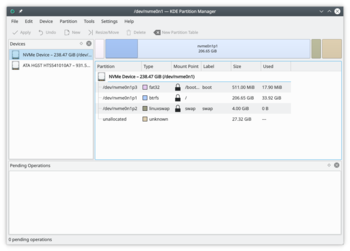KDE Partition Manager/da: Difference between revisions
Importing a new version from external source |
Importing a new version from external source |
||
| Line 2: | Line 2: | ||
{|class="tablecenter vertical-centered" | {|class="tablecenter vertical-centered" | ||
|[[Image:Partitionmanager1.png|thumb|350px|Main Window]]|| ''' | |[[Image:Partitionmanager1.png|thumb|350px|Main Window]]|| '''Håndtering af lagerenheder, partitioner og filsystemer på din computer.''' | ||
|} | |} | ||
Revision as of 20:36, 4 October 2010
 |
Håndtering af lagerenheder, partitioner og filsystemer på din computer. |
General
KDE Partition Manager is a utility program to help you manage the disk devices, partitions and file systems on your computer.
It allows you to easily create new partitions, create file systems on new or existing partitions, copy, move or delete partitions and also to modify a partition's size without losing the data on it.
User Interface
Besides the main view showing the currently selected device in a graphical and a tree view, KDE Partition Manager uses Qt's "dock widgets" (or "panels") to display some information and allow selections. See the screen shot at the top of this page for an overview.
External Dependencies
To get its job done efficiently KDE Partition Manager makes use of external tools to support a long list of file systems. You will probably have the required tools for the file systems on your computer installed already if you use a mainstream Linux distribution.
The KDE Partition Manager handbook has all the details which external package is required for what.
